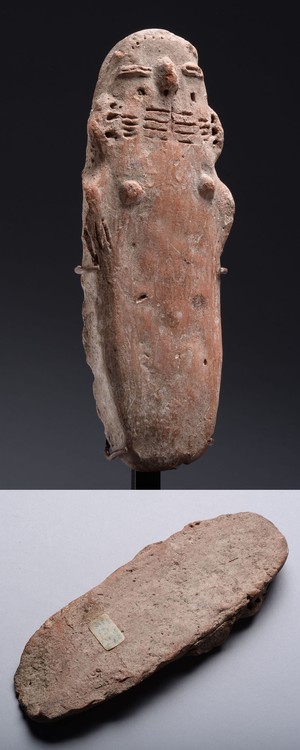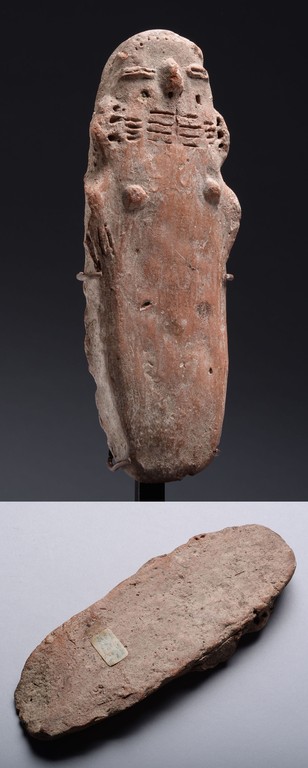Cypriot slab plank figure.: Middle Bronze Age II-III (1850-1700 BC)
Later type of the flat Plank Figures, called by Desmond Morris "slab figures" since the head and neck are subsumed within the body shape with no shoulders. It was a designation in which he included the stone planks which may have a separate origin, or even a different use, from the classic earlier type, which is characterised as a rectangular body with a smaller rectangle representing the head, and with a protuberant nose (the latter in all but 2 cases I am aware of) and often pierced ears protruding to each side. Here there are slight lateral bulges, suggesting shoulders and arms. Later, incised decorations gave way to applied decorations (in this case eyebrows in relief) and frequently the depiction of arms, usually in relief. Slab figures probably date from a little later in the Middle Bronze Age though possibly overlapping the classic types. Small, high, widely applied breasts had been an unusual feature in classic shoulder figures (about 10%) but found in the majority of these later types. This figure also has ears with 3 piercings for earrings and puncture marks for nostrils and eyes, and tiny punctures possibly representing hair. Below the nose is a vertical incised line with groups of horizontal markings on each side, possibly representing facial decoration with tattoos or scarification or simply paint. Ear piercings are so much insisted on in Cypriot anthropomorphic figures from the Bronze Age, even when almost no other features are indicated, that they must be a marker of status. Figures with arms and relief details (other than breasts and nose) almost all come from central Cyprus. The horizontal facial marks are often found on the classic plank figures but rarely on slab figures and is thought to represent tattoos, scarification or face painting . Like many of these later figures, the piece has none of the body markings (probably represent patterns on clothing and jewellery) which are always present on the classic type. If the figure had not had breasts, the facial markings could also have been interpreted as a beard and moustache. The straight arms by the sides (with fingers indicated by incisions, as in the later Astarte figures) are also unusual. Although representing the beginning of new approaches to a static form, these figures also feel like a degeneration of the hieratic plank figure. This figure, which is very crude, has a blank back. This is extremely unusual and certainly none of the classic figures are like this. Normally plank figures are worked on all sides and have a flat bottom edge. However a few, such as MS77 at the Pennsylvania Museum are similar to this one.
I believe that all plank figures represented ancestor figures. These were probably individual, named ancestors, but were possibly generic. The figures may have functioned as shrines within the home, intended to actually contain ancestral spirits. In this context the round base is strange as it would be hard to keep the figure standing up, unless there were a slot in the floor. However unlike the classic figures this is of a size which could comfortably be held in the hand. Although most of the classic figures are a little under 30cm they can be as little as 10cm high. There is a tendency for these slightly later, variant figures to be of this smaller size.
See the other 4 plank figures (under "Early Bronze Age" even though they probably date from EC III - MC I). The article on the second (with narrow head and neck) has more details on plank figures' possible uses and relation to other artefacts and beliefs.
Unrestored with only minor chips. Remains of old collection labels front and (chiefly) back.
Size: 18.3 cm high
(From the collection of Georges Halphen (1913-2003), acquired 18.12.1970. An old label on the back of the figure reading “Idole Chypre, Terre Cuite 3 mill [?]CP 18.12.70. 94 no 13 930”. Georges Halphen was the son of the composer Fernand Halphen and his wife, Alice de Koenigswarter. He was a life-long collector and donated works to the Musée d’Orsay and the Musée du quai Branly. Subsequently sold at Christies, Paris 20th November 2003, lot no. 510. Exported from France under export license no. 061589. Subsequently UK private collection. Acquired from the above by ArtAncient, 2017.)
(Aquired Art Ancient August 2017)
DJ86

